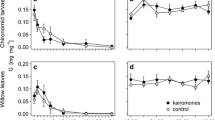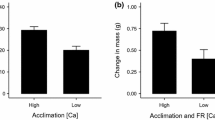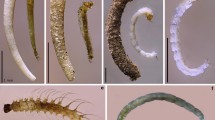Abstract
The Ponto-Caspian amphipod Dikerogammarus villosus has invaded Central European and British freshwaters and its arrival is associated with biodiversity decline, as D. villosus is predatory towards many macroinvertebrate taxa, including resident amphipods such as Crangonyx pseudogracilis and isopods such as Asellus aquaticus. I investigated how differential physiological tolerance, habitat use and predation may drive coexistence or exclusion among D. villosus and resident ‘supertramp’ prey such as C. pseudogracilis. Experiments revealed that D. villosus could not survive 12 h in the extremely poor water qualities that C. pseudogracilis and A. aquaticus commonly live. Experiments manipulating oxygen levels, revealed low survivorship of C. pseudogracilis and A. aquaticus in the presence of D. villosus at higher oxygen levels but this survivorship increased significantly as oxygen levels fell. Predation of C. pseudogracilis by a resident amphipod Gammarus pulex followed a similar pattern but was much less severe and A. aquaticus appeared resistant to G. pulex predation. Mesocosm experiments showed that C. pseudogracilis survivorship in the presence of D. villosus increased when dense vegetation was present compared to bare substrate. Survivorship of A. aquaticus was uniformly poor in all habitats. Taxa with high environmental tolerance and adaptability may be resistant to this invader’s worst impacts.




Similar content being viewed by others
References
Arbačiauskas, K., V. Semenchenko, M. Grabowski, R. S. E. W. Leuven, M. Paunovic, M. O. Son, B. Csanyi, S. Gumuliauskaite, A. Konopacka, S. Nehring, G. van der Velde, V. Vezhnovetz & V. E. Panov, 2008. Assessment of biocontamination of benthic macroinvertebrate communities in European inland waterways. Aquatic Invasions 3: 211–230.
Arndt, E., S. Fielder & D. Böhme, 2009. Effects of invasive benthic macroinvertebrates on assessment methods of the EU Water Framework Directive. Hydrobiologia 635: 309–320.
Balke, M., I. Ribera, L. Hendrich, M. A. Miller, K. Sagata, A. Posman, A. P. Vogler & R. Meier, 2009. New Guinea highland origin of a widespread arthropod supertramp. Proceedings of the Royal Society of London B: Biological Sciences 276: 2359–2367.
Beggel, S., J. Brandner, A. F. Cerwenka & J. Geist, 2016. Synergistic impacts by an invasive amphipod and an invasive fish explain native gammarid extinction. BMC Ecology 16: 32.
Bock, D. G., C. Caseys, R. D. Cousens, M. A. Hahn, S. M. Heredia, S. Hűbner, K. G. Turner, K. D. Whitney & L. H. Rieseberg, 2015. What we still don’t know about invasion genetics. Molecular Ecology 24: 2277–2297.
Boets, P., K. Lock, M. Messiaen & P. L. M. Goethals, 2010. Combining data-driven methods and lab studies to analyse the ecology of Dikerogammarus villosus. Ecological Informatics 5: 133–139.
Boets, P., I. S. Pauwels, K. Lock & P. L. M. Goethals, 2014. Using an integrated modelling approach for risk assessment of the ‘killer shrimp’ Dikerogammarus villosus. River Research and Applications 30: 403–412.
Bruijs, M. C. M., B. Kelleher, G. Van der Velde & A. Bij de Vaate, 2001. Oxygen consumption temperature and salinity tolerance of the invasive amphipod Dikerogammarus villosus: indicators of further dispersal via ballast water transport. Archive für Hydrobiologie 152: 633–646.
Cardoso, A. C. & G. Free, 2008. Incorporating invasive alien species into ecological assessment in the context of the Water Framework Directive. Aquatic Invasions 3: 361–366.
Carlsson, R., 2000. The distribution of the gastropods Theodoxus fluviatilis (L.) and Potamopyrgus antipodarum (Gray) in lakes on the Ǻland Islands, southwestern Finland. Boreal Environmental Research 5: 187–195.
Clinton, K. E., K. L. Mathers, D. Constable, C. Gerrard & P. J. Wood, 2018. Substrate preferences of coexisting invasive amphipods, Dikerogammarus villosus and Dikerogammarus haemobaphes, under field and laboratory conditions. Biological Invasions 20: 2187–2196.
Colinvaux, P., 1986. Ecology. Wiley, New York.
Devin, S., C. Piscart, J. N. Beisel & J. C. Moreteau, 2003. Ecological traits of the amphipod invader Dikerogammarus villosus on a mesohabitat scale. Archive fűr Hydrobiologie 158: 43–56.
Diamond, J. M., 1974. Colonization of exploded volcanic islands by birds: The supertramp strategy. Science 184: 803–806.
Dick, J. T. A., 1996. Post-invasion amphipod communities of Lough Neagh, N. Ireland: influences of habitat selection and mutual predation. Journal of Animal Ecology 65: 756–767.
Dick, J. T. A. & D. Platvoet, 2000. Invading predatory crustacean Dikerogammarus villosus eliminates both native and exotic species. Proceedings of the Royal Society of London B: Biological Sciences 267: 977–983.
Dick, J. T. A., S. E. Faloon & R. W. Elwood, 1998. Active brood care in an amphipod: influences of embryonic development, temperature and oxygen. Animal Behavior 56: 663–672.
Dick, J. T. A., D. Platvoet & D. W. Kelly, 2002. Predatory impact of the freshwater invader Dikerogammarus villosus (Crustacea: Amphipoda). Canadian Journal of Fisheries and Aquatic Sciences 59: 1078–1084.
Fowler, J., L. Cohen & P. Jarvis, 2008. Practical Statistics for Field Biology, 2nd ed. Wiley, England.
Gallardo, B. & D. C. Aldridge, 2013. The ‘dirty dozen’: socio-economic factors amplify the invasion potential of 12 high-risk aquatic invasive species in Great Britain and Ireland. Journal of Applied Ecology 50: 757–766.
GBNNSS, 2017. GB non-native species secretariat species alerts. http://www.nonnativespecies.org/alerts/index.cfm.
Gledhill, T., D. W. Sutcliffe & W. D. Williams, 1993. British Freshwater Crustacea Malacostraca: a Key with Ecological Notes. Freshwater Biological Association Scientific Publications No. 52. Freshwater Biological Association, Ambleside.
Hellmann, C., S. Worischka, E. Mehler, J. Becker, R. Gergs & C. Winkelmaan, 2015. The trophic function of Dikerogammarus villosus (Sowinsky, 1894) in invaded rivers: a case study in the Elbe and Rhine. Aquatic Invasions 10: 385–397.
Holland, D. G., 1976. The distribution of the freshwater Malacostraca in the area of the Mersey and Weaver River Authority. Freshwater Biology 6: 265–276.
Hynes, H. B. N., 1960. The Biology of Polluted Waters. Liverpool University Press, Liverpool.
Jermacz, Ł., A. Dzierżyńska, T. Kakareko, M. Poznańska & J. Kobak, 2015. The art of choice: predation risk changes interspecific competition between freshwater amphipods. Behavioural Ecology 26: 656–664.
Jermacz, Ł., A. Dzierżyńska-Białonczyk & J. Kobak, 2017. Predator diet, origin or both? Factors determining responses of omnivorous amphipods to predation cues. Hydrobiologia 785: 173–184.
Jourdan, J., B. Westerwald, A. Kiechle, W. Chen, B. Streit, S. Klaus, M. Oetken & M. Plath, 2016. Pronounced species turnover, but no functional equivalence in leaf consumption of invasive amphipods in the river Rhine. Biological Invasions 18: 763–774.
Kinzler, W., A. Kley, G. Maye, D. Waloszek & G. Maier, 2009. Mutual predation between and cannibalism within several freshwater gammarids: Dikerogammarus villosus versus one native and three invasives. Aquatic Ecology 43: 457–464.
Kley, A. & G. Maier, 2005. An example of niche partitioning between Dikerogammarus villosus and other invasive and native gammarids: a field study. Journal of Limnology 64: 85–88.
Koester, M. & R. Gergs, 2014. No evidence for intraguild predation of Dikerogammarus villosus (Sowinsky, 1894) at an invasion front in the Untere Lorze, Switzerland. Aquatic Invasions 9: 489–497.
Kobak, J., Ł. Jermacz & A. Dzierżyńska-Białończyk, 2015. Substratum preferences of the invasive killer shrimp Dikerogammarus villosus. Journal of Zoology 297: 66–76.
Kobak, J., M. Rachalewski & K. Bącela-Spychalska, 2016. Conquerors or exiles? Impact of interference competition among invasive Ponto-Caspian gammarideans on their dispersal rates. Biological Invasions 18: 1953–1965.
Kobak, J., L. Jermacz, J. Marcinczyk, E. Bartoszynska, D. Rutkowska & K. Pawlowska, 2017. Abiotic factors affecting habitat selection by two invasive gammarids Dikerogammarus villosus and Pontogammarus robustoides. Hydrobiologia 797: 247–263.
Koester, M., B. Bayer & R. Gergs, 2016. Is Dikerogammarus villosus (Crustacea, Gammaridae) a ‘‘killer shrimp’’ in the River Rhine system? Hydrobiologia 768: 299–313.
Llewelyn, J., B. L. Phillips, R. A. Alford, L. Schwarzkopf & R. Shine, 2010. Locomotor performance in an invasive species: cane toads from the invasion front have greater endurance, but not speed, compared to conspecifics from a long-colonised area. Oecologia 162: 343–348.
MacNeil, C. & D. Platvoet, 2005. The predatory impact of the freshwater invader Dikerogammarus villosus on native Gammarus pulex (Crustacea: Amphipoda); influences of differential microdistribution and food resources. Journal of Zoology 267: 1–8.
MacNeil, C. & J. T. A. Dick, 2014. Differential physicochemical tolerances, habitat utilization and predation drive patterns of coexistence and exclusion among invasive and resident amphipods. Freshwater Biology 59: 1956–1969.
MacNeil, C. & D. Platvoet, 2013. Factors influencing the macro- and micro-distribution of Dikerogammarus villosus (Crustacea: Amphipoda) within an invaded river system; could artificial structures such as fish passes facilitate the establishment and spread of the ‘killer shrimp’? Aquatic Conservation: Marine and Freshwater Ecosystems 23: 667–677.
MacNeil, C., J. T. A. Dick & R. W. Elwood, 1997. The trophic ecology of freshwater Gammarus (Crustacea : Amphipoda); perspectives concerning the functional feeding group concept. Biological Reviews 72: 349–364.
MacNeil, C., R. W. Elwood & J. T. A. Dick, 1999. Differential microdistributions and interspecific interactions in coexisting Gammarus and Crangonyx amphipods. Ecography 22: 415–423.
MacNeil, C., J. T. A. Dick & R. W. Elwood, 2000. Differential physico – chemical tolerances of amphipod species revealed by field transplantations. Oecologia 124: 1–7.
MacNeil, C., J. T. A. Dick, R. W. Elwood & W. I. Montgomery, 2001. Coexistence among native and introduced freshwater amphipods (Crustacea); habitat utilisation patterns in littoral habitats. Archive für Hydrobiologie 151: 591–607.
MacNeil, C., J. T. A. Dick, C. Gibbins, R. W. Elwood & W. I. Montgomery, 2002. A reappraisal of the Gammarus: Asellus ratio as an index of organic pollution in rivers. Water Research 36: 75–84.
MacNeil, C., J. Prenter, M. Briffa, N. J. Fielding, J. T. A. Dick, G. E. Riddell, M. J. Hatcher & A. M. Dunn, 2004. The replacement of a native freshwater amphipod by an invader: roles for environmental degradation and intraguild predation. Canadian Journal of Fisheries and Aquatic Sciences 61: 1627–1635.
MacNeil, C., J. T. A. Dick, F. R. Gell, R. Selman, P. Lenartowicz & H. B. N. Hynes, 2009. A long-term study (1949-2005) of experimental introductions to an Island; freshwater amphipods (Crustacea) in the Isle of Man (British Isles). Diversity and Distributions 15: 232–241.
MacNeil, C., D. Platvoet, J. T. A. Dick, N. Fielding, A. Constable, N. Hall, D. Aldridge, T. Renals & M. Diamond, 2010. The Ponto-Caspian ‘killer shrimp’, Dikerogammarus villosus (Sowinsky, 1894), invades the British Isles. Aquatic Invasions 5: 441–445.
MacNeil, C., J. T. A. Dick, D. Platvoet & M. Briffa, 2011. Direct and indirect effects of species displacements; the invading amphipod crustacean Dikerogammarus villosus can disrupt aquatic ecosystem energy flow and function. Journal of the North American Benthological Society 30: 38–48.
MacNeil, C., P. Boets & D. Platvoet, 2012. ‘Killer shrimps’, dangerous experiments and misguided introductions; how freshwater shrimp (Crustacea: Amphipoda) invasions threaten biological water quality monitoring in the British Isles. Freshwater Reviews 5: 21–35.
MacNeil, C., P. Boets, K. Lock & P. L. M. Goethals, 2013. Potential effects of the invasive ‘killer shrimp’ (Dikerogammarus villosus) on macroinvertebrate assemblages and biomonitoring indices. Freshwater Biology 58: 171–182.
Madgwick, G. & D. C. Aldridge, 2011. Killer shrimps in Britain: hype or horror? The facts about our latest invasive animal. British Wildlife 22: 408–412.
Marcus, A. & K. Grabow, 2008. Das Risiko der Verschleppung neozoischer Amphipods beim Überlandtransport von Yachten. Risk of spreading of non-indigenous Amphipoda due to overland transport of recreation boats. Lauterbornia 62: 41–44.
Maazouzi, C., C. Piscart, J. C. Pihan & G. Masson, 2009. Effect of habitat-related resources on fatty acid composition and body weight of the invasive Dikerogammarus villosus in an artificial reservoir. Fundamentals of Applied Limnology 175: 327–338.
Pinkster, S., M. Scheepmaker, D. Platvoet & N. Broodbaker, 1992. Drastic changes in the amphipod fauna (Crustacea) of Dutch inland waters during the last 25 years. Bijdragen tot de Dierkunde 61: 193–204.
Rewicz, T., M. Grabowski, C. MacNeil & K. Bacela-Spychalska, 2014. The profile of a ‘perfect’ invader – the case of the killer shrimp. Dikerogammarus villosus. Aquatic Invasions 9: 267–288.
Strayer, D. L. & D. Dudgeon, 2010. Freshwater biodiversity conservation: recent progress and future challenges. Journal of the North American Benthological Society 29: 344–358.
Sykes, J. M., A. M. J. Lane & D. G. George, 1999. The United Kingdom Environmental Change Network: Protocols for Standard Measurements at Freshwater Sites. Centre for Ecology and Hydrology. Natural Environment Research Council, Huntingdon, Cambs.
Turnbull, D. A. & J. R. Bevan, 1995. The impact of airport deicing on a river: the case of the Ouseburn, Newcastle Upon Tyne. Environmental Pollution 88: 321–332.
Van Riel, M. C., E. P. Healy, G. Van der Velde & A. Bij de Vaate, 2007. Interference competition among native and invader amphipods. Acta Oecologia 31: 282–289.
Acknowledgements
Thanks to Fiona MacNeil and Carl Haynes of Summerfield Farm campsite for use of all facilities and cold rooms. Thanks to the Government Laboratory, Isle of Man. Thanks also to Nina Birkby of the Environment Agency of England and Wales and Mark Briffa of the University of Plymouth. Thanks to Katya Kovalenko and referees whose comments improved this manuscript.
Author information
Authors and Affiliations
Corresponding author
Additional information
Handling editor: Katya E. Kovalenko
Rights and permissions
About this article
Cite this article
MacNeil, C. Predatory impacts of the invasive ‘killer shrimp’ Dikerogammarus villosus on a resident amphipod and isopod (Crustacea: Malacostraca) are influenced by water quality and habitat type. Hydrobiologia 833, 53–64 (2019). https://doi.org/10.1007/s10750-018-3881-8
Received:
Revised:
Accepted:
Published:
Issue Date:
DOI: https://doi.org/10.1007/s10750-018-3881-8




